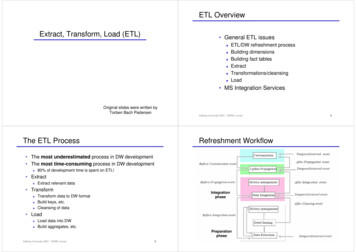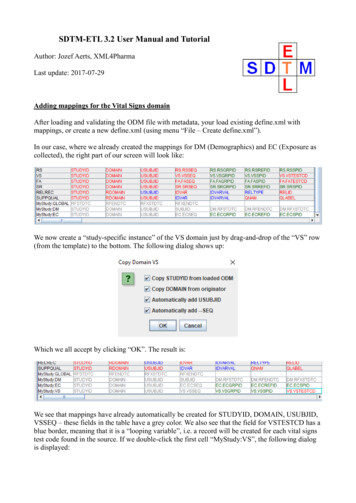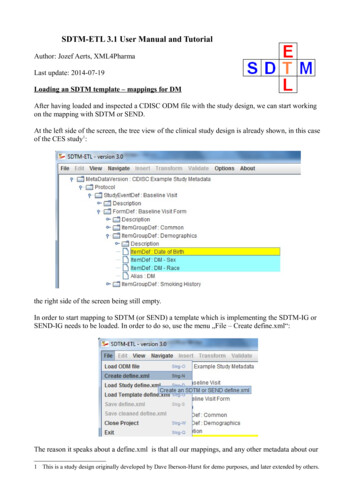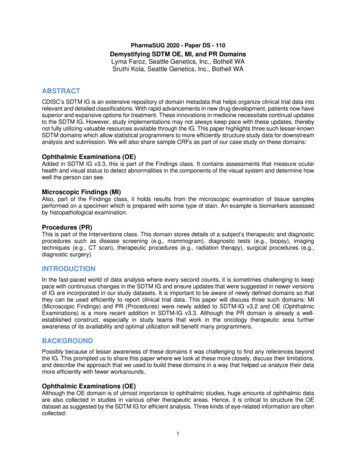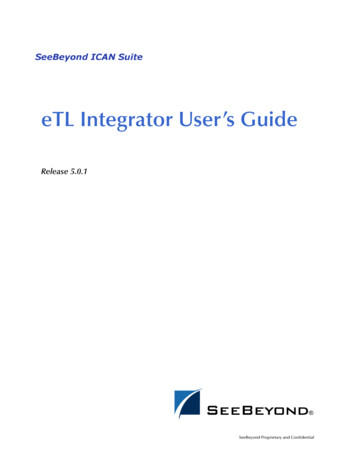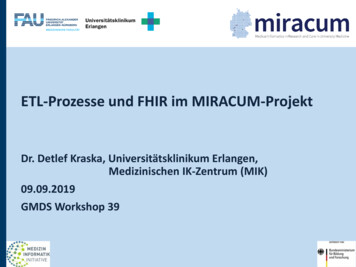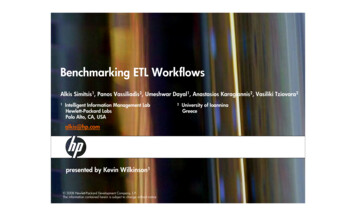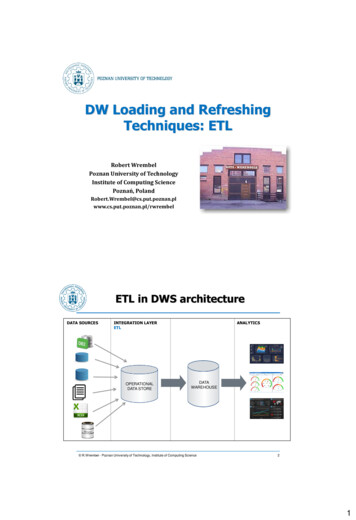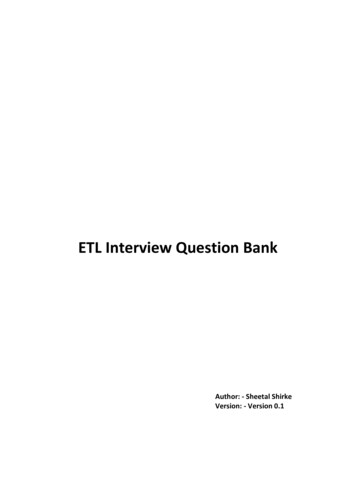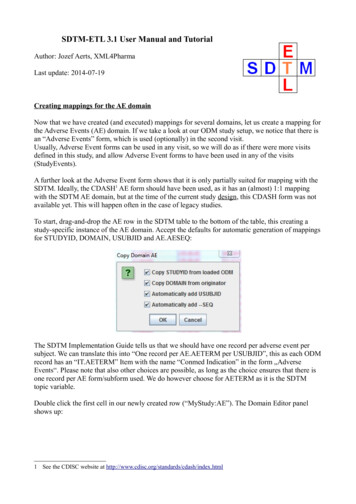
Transcription
SDTM-ETL 3.1 User Manual and TutorialAuthor: Jozef Aerts, XML4PharmaLast update: 2014-07-19Creating mappings for the AE domainNow that we have created (and executed) mappings for several domains, let us create a mapping forthe Adverse Events (AE) domain. If we take a look at our ODM study setup, we notice that there isan “Adverse Events” form, which is used (optionally) in the second visit.Usually, Adverse Event forms can be used in any visit, so we will do as if there were more visitsdefined in this study, and allow Adverse Event forms to have been used in any of the visits(StudyEvents).A further look at the Adverse Event form shows that it is only partially suited for mapping with theSDTM. Ideally, the CDASH1 AE form should have been used, as it has an (almost) 1:1 mappingwith the SDTM AE domain, but at the time of the current study design, this CDASH form was notavailable yet. This will happen often in the case of legacy studies.To start, drag-and-drop the AE row in the SDTM table to the bottom of the table, this creating astudy-specific instance of the AE domain. Accept the defaults for automatic generation of mappingsfor STUDYID, DOMAIN, USUBJID and AE.AESEQ:The SDTM Implementation Guide tells us that we should have one record per adverse event persubject. We can translate this into “One record per AE.AETERM per USUBJID”, this as each ODMrecord has an “IT.AETERM” Item with the name “Conmed Indication” in the form „AdverseEvents“. Please note that also other choices are possible, as long as the choice ensures that there isone record per AE form/subform used. We do however choose for AETERM as it is the SDTMtopic variable.Double click the first cell in our newly created row (“MyStudy:AE”). The Domain Editor panelshows up:1 See the CDISC website at http://www.cdisc.org/standards/cdash/index.html
We select two levels of looping, the second being AE.AETERM.If we use define.xml 2.0, there is also a button „Set domain keys and sequence“. Clicking it pops upthe dialog:You can now add some variables using the „Add “ button and change the order with the „Moveup“ and „Move down“ buttons. In earlier days, the SDTM-IG gave some suggestions for the keys,but most sponsors just copied these without further thinking2. You might e.g. choose for:2 It is however also not clear whether the FDA is doing anything with this information! The define.xml 2.0specification states that adding domain keys in the context of a regulatory submission. To our knowledge, the FDAis not loading submission datasets in a database, so we wonder why these keys are necessary.
The next time you will edit the domain properties and hold the mouse over the button, you will find:After having edited the domain properties, we can start with the mappings.We do already have a mapping for USUBJID (automatically generated), so we must still generate amapping for AE.AETERM. It is always good practice to first develop mappings for those SDTMvariables that are looping variables (usually that is the topic variable), so let us do this one first.As already stated the ODM has an Item “Conmed Indication” with OID “IT.AETERM”. When weclick in the SDTM cell for AE.AETERM, we even see that this Item is a “hot candidate” for themapping (meaning that it has an annotation that its SDTM target3 is “AETERM”):3 In the ODM, this is either accomplished by the „SDSVarName“ attribute on ItemDef, or by an „Alias“ elementhaving „SDTM“ for the „Context“ attribute.
The square around the „traffic light“ indicating that the item is a „hot candidate“ for the SDTMvariable „AETERM“.If the item in the tree is not visible yet, we also can always find the „hot candidate“ using the menu„Navigate – Find hot SDTM Candidate„:Just drag-and-drop the Item „Conmed Indication“ from the left side to the cell “AE.AETERM”. Thefollowing dialog shows up:
We accept the default that will retrieve the value from the clinical data („ItemData Value attribute“)As we want to take care that AE forms from all visits are taken into account (although in this studyit is only used in the second visit, as there are only two visits), we need to check the checkbox“Generalize for all StudyEvents”. Later we will learn how to be more precise which visits exactlymust be selected (unimportant in this case) using the „Except for .“ and „Only for .“ buttons.We are also warned that in the ODM, the value for „Conmed Indication“ may be up to 100characters long, whereas our define.xml template has a default of max. 80 characters for thisvariable. When we check the checkbox „Set SDTM Variable Length to ODM ItemDef Length“, thiswill automatically be corrected, and the SDTM „Length“ will be set to 100 too4.When clicking OK, this correction is again confirmed:The transformation script is now automatically generated:A „mapping description“ is automatically created, which you might want to adapt. The information4 It is NOT a good idea to set the length for all variables to the SAS-XPT maximum of 200, as this will generateextremely large SAS-XPT data sets that the FDA cannot handle. Also, setting a correct maximum length will helpgenerating an optimized database (see „Generating an SDTM database“)
in it will go into the „Description“ element of the corresponding „MethodDef“ element in theunderlying define.xml (in case define.xml 2.0 is used).We can test it using the button “Test – Transform to XSLT”. We get something like:after having used the „Test XSLT on ODM Clinical Data“ button and having provided a file withclinical data for this study. We also see that some subjects have not have any adverse events (e.g.subjects 005, 006, 007). When later executing the mappings, no AE records will be generated forthese subjects.Define.xml 2.0 also requires to provide the „Origin“ of each SDTM variable when the context is aregulatory submission. To add it for AETERM, use the menu „Edit – SDTM Variable Properties“and then look for the checkbox „New Origin“:You can now add the „Origin“ by checking the checkbox followed by clicking the „Edit“ button5.This gives:5 If you use define.xml 1.0, you will see that „Origin“ is free text, and you will find a text field.
In this case, it is clear that the origin is „CRF“, so we need to check that checkbox:We must associate a define.xml def:leaf with the annotated CRF, but we haven't got one yet, so weneed to create one first by returning to the main window, and use the menu „Insert – Link toannotated CRF“6:6 If you have annotated your ODM study design well, this should essentially serve the purpose of the „annotatedCRF“. However, the FDA does not accept this yet – you still need to provide an oldfashioned PDF, even in the caseno paper was used in the study (e.g. in the case of eCRFs)
and use the „Browse“ button to add the location of your aCRF.You can then add this information again to the „AETERM“ variable using the „Edit – SDTMVariable“ again:and also add the page number to the field „Page list“If you do not have an annotated CRF in PDF format yet, you can of course skip this step, and addthe information later.The second SDTM variable we want to develop a mapping for is AE.AEDECOD (“Dictionaryderived term”, usually the MedDRA preferred term). As we haven't got anything better, we just usethe same mapping as for AE.AETERM for the moment7.The “CDISC Notes” tell us that the sponsor need to give the dictionary name and version in the“Comments” column in the define.xml document. This can easily be done by selecting theAE.AEDECOD cell, and then use the menu “Edit - SDTM Variable Properties”. We can then addthe information in the input field for “Comment”:7 If you have a MedDRA database or tool, we can help you generating a connection to it for mapping purposes.
The next SDTM variable we can develop a mapping for is the variable AE.AESEV(Severity/Intensity). When we select the cell, we see that there is an ODM “hot candidate”IT.AESEV („Severity“), which is however governed by a codelist.As indicated by the square around the „traffic light“ and the blue color of it (indicating there is anassociated codelist). To see the details of the codelist at the ODM side, select the Item „Severity“and then use the menu “Navigate - Select associated CodeList” (Ctrl-F2). The selection jumps tothe associated CodeList in the ODM tree and expands its tree node:We observe that there are four possibilities with coded values “1”, “2”, “3” or “4” (these can beseen in the status field at the bottom when selecting a “CodeListItem”, and decoded values “Mild”,“Moderate”, “Severe” and “Life Threatening”.The SDTM-IG tells us that there is controlled terminology for AESEV and provides a reference tothe NCI website. There we can find that there is a codelist „CL.C66769.AESEV“ which howeveronly has 3 allowed values: „MILD“, „MODERATE“ and „SEVERE“. It also states that the codelistis non-extensible. Unfortunately the SDTM-IG is also not very clear on whether one must use thatcodelist. It states: „The severity or intensity of the event. Examples: MILD, MODERATE,SEVERE“. Especially, the wording „Examples“ is confusing.
We now have the choice between two approaches:a) map the 4 possibible values from the study design to the three values of the „recommended“SDTM-IG codelist with only 3 values. If we do so, we should document this in the „reviewersguide“ but also in the „annotated CRF“b) copy our own „SEVERITY“ codelist from the ODM (study design) to the SDTM, and use that.We will use the first approach (only as an example8).Now just drag-and-drop the ItemDef “Severity” to the SDTM cell “AE.AESEV”. The followingdialog shows up:This time, we do NOT check the button „Set SDTM Variable Length to ODM ItemDef Length“ aswe will use a different codelist on the SDTM site. Do not forget to check the box „Generalize for allStudy Events“ if it was not automatically checked yet. Clicking „OK“ leads to:8 In such cases, the mapper should decide himself / herself which of the 2 approaches is most appropriate
Where we select „Use CodeList from SDTM variable“ (which is the CDISC-NCI codelist). Thenclicking „OK“ leads to:which allows us to do the mapping between both the codelists.As we know that „1“ stands for „Mild“, „2“ for „Moderate“ and „3“ for „Severe“, we just use thedropdowns leading to:
where we map „life threatening“ to „severe“.For „Missing“ value, we just map to „blank“ - this will give a null value in the later result.So we have:The button „Attempt 1:1 mapping based on coded values“ can be used in case of long codelists. Thesystem will then try to compare both and come with a suitable proposal for the mappings. Afterclicking „OK“, the „mapping editor“ shows up and the result is:
So the system has automatically generated a mapping script – no need for typing!Of course one can always edit/adapt the mapping script, but in this case, this is not necessary at all.Also note that comment lines (all starting with „#“ have automatically been generated).The next SDTM variable on our list is AE.AESER (“Is this a serious event?). The possible valuesare “Y” (Yes) and “N” (No). We see that there is no corresponding item in the ODM, so we will(arbitrarily) add “N” values for mild and moderate adverse events, and “Y” for severe and lifethreatening adverse events.Drag-and-drop from IT.AESEV (ItemDef: Severity) to the SDTM cell AE.AESER. Check again togeneralize for all visits (StudyEvents). We get:
We better choose the codelist from the SDTM Variable. Check the radiobutton and then click thebutton “Show Codelist Details”:Remark that dependent on which version of CDISC-CT you have chosen when loading thetemplate, you might see slightly different things here.Again, the codelist mapping tool is then displayed. We map to:
Which leads to the automatically created mapping script:Also remark the automatically created comment line, allowing us later to remember how themapping script was generated9.In case such an arbitrary decision is made, it is surely not a bad habit to explain that decision in the“Comments” field of the define.xml. You can do so using the menu “Edit SDTM VariableProperties”, and add your comment in the field “Comment”:For a regulatory submission, define.xml 2.0 also requires that the „Origin“ is provided, either on thevariable level or on the valuelist level. We can easily add it using the „New Origin“ checkboxfollowed by „Edit“:9 And which can also be read by the FDA reviewer when inspecting the “Methods” in the submitted define.xml file.
and in this case set it to „Derived“.Note: when having finished mapping a domain / dataset, it is surely a good idea to check whethereach variable has been assigned an „Origin“. The absence of it is NOT marked as an error evenwhen using OpenCDISC, as the latter cannot know whether the context of the define.xml is aregulatory submission.The next SDTM variable is AE.AEACN (Action taken with study treatment).When clicking the cell, we see that there is an ODM “hot candidate” “Actions take re study drug”.Alternatively, we can search for a „hot candidate“ on the ODM side using the menu „Navigate –Find hot SDTM Candidate“. We find:Drag-and-drop, and generalizing for all StudyEvents gives us the dialog asking us which codelist touse. Again we can use the already associated SDTM codelist:
Clicking “OK” gives us the codelist mapping wizard, which easily leads us to the followingmapping:and again, the mapping script is automatically generated:
At this point, let us try to execute the full mapping that we have so far on a set of clinical data, justas a check that we are doing the right things. For this, use the menu “Transform - GenerateTransformation (XSLT) Code for CDISC Dataset-XML” (alternatively you can also use „GenerateTransformation (XSLT) Code for SAS-XPT“) followed by “Excecute Transformation (XSLT)Code”:Note that there is no checkbox „Split records 200 characters to SUPP-- records“ as this is notnecessary anymore when using Dataset-XML instead of SAS-
SDTM-ETL 3.1 User Manual and Tutorial Author: Jozef Aerts, XML4Pharma Last update: 2014-07-19 Creating mappings for the AE domain Now that we have created (and executed) mappings for several domains, let us create a mapping for the Adverse Events (AE) domain. If we take a look at our ODM study setup, we notice that there is an “Adverse Events” form, which is used (optionally) in the second .
